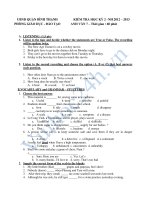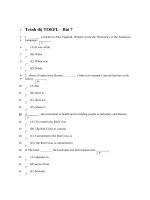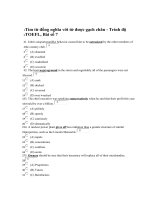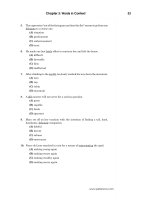Verb form 7 pot
Bạn đang xem bản rút gọn của tài liệu. Xem và tải ngay bản đầy đủ của tài liệu tại đây (74.03 KB, 6 trang )
Answer Explanations
The following model essays earn a 6 on the AWA section, the top score on the written exam. Both essays have
most or all of the following characteristics:
– ANALYTICAL WRITING ASSESSMENT PRETEST–
218
The content of your
written response
shows an under-
standing and inter-
pretation of the
issue or argument
and the task pre-
sented in the
prompt.
The development of
your written
response gives a
clear and logical
explanation of ideas
using specific and
relevant support.
The organization of
your written
response shows a
coherent, orderly,
and well-reasoned
approach.
The expression of
your ideas reflects
an awareness of
audience, a com-
mand of vocabulary
and sentence struc-
ture, and an ability
to use language to
convey purpose.
The use of standard
English in your writ-
ten response
exhibits the correct
use of spelling,
punctuation, para-
graph organization,
capitalization, and
grammar.
■
Forms a thesis
statement that
reveals an in-
depth under-
standing of the
issue or argu-
ment.
■
Presents a
sophisticated
and insightful
analysis of the
issue or argu-
ment.
■
Develops ideas
clearly and fully.
■
Provides a wide
range of relevant
and specific evi-
dence to support
the thesis state-
ment.
■
Maintains the
focus of the the-
sis statement.
■
Uses a logical
and coherent
structure.
■
Applies skillful
writing devices
and transitions.
■
Exhibits a
mature, sophisti-
cated use of lan-
guage that is
precise and
engaging.
■
Has a voice and
a sense of aware-
ness of audience
and purpose.
■
Varies the struc-
ture and length of
sentences to
enhance
meaning.
■
Shows control of
the conventions
of standard
English.
■
Has few, if any,
errors even when
using sophisti-
cated language.
CONTENT DEVELOPMENT ORGANIZATION EXPRESSION CONVENTIONS
Sample Essay
—
Analysis of an Issue (Score: 6)
All for-profit corporations have a moral responsibility to contribute to society by supporting education, non-
profit services, or the arts. In today’s increasingly global marketplace, companies that embrace their social
responsibilities and empower their leaders and employees to serve local and world communities will reap
rewards now and for years to come. These companies will realize that they will reap long-term benefits in
morale and bottom-line growth and sustainability by giving their personnel the opportunity to work toward
higher goals (social responsibilities) and to make a difference in their lives and the lives of the people around
them.
Every organization has a legal responsibility to serve its immediate (or local) community as a produc-
tive “citizen”by obeying and upholding the laws that govern its operations and by giving its employees a safe
place to work. Yet, a select group of modern companies take their social responsibilities a step further, mov-
ing beyond mere compliance and into a heightened awareness of social responsibility. These companies oper-
ate under “enlightened self-interest.” They realize that what is good for the community and for society is good
for the company, and they spend a tremendous amount of effort and money incorporating social programs
into their corporate infrastructures and even encouraging and rewarding social involvement and leadership.
These companies go beyond merely making grants to nonprofit groups or arts programs. Even more
importantly, in addition to monetary gifts to these types of social organizations, they set up hearty volun-
teerism programs through which employees at all levels are encouraged to participate in organized volun-
teer activities. Typically, they match skills to needs. For instance, researchers at a pharmaceutical company
might be organized to help tutor students in science.
Although some may argue that corporations have a responsibility only to their stakeholders and their
bottom line and do not legally have a responsibility to “do good” in society, they miss the point that social
responsibility is in the best interest of the company. Companies that actively participate in social programs
aimed at curbing crime, fighting poverty and illiteracy, and teaching skills to those in need reap bottom-line
benefits from their social programs every day. These programs not only have a positive impact on the local
communities where they are enacted, but they also continue to deliver dividends to the organization in pos-
itive public relations, building the image of the company in the eyes of the community and developing a more
effective employee base.
Corporations that contribute to society benefit on the inside as well. Employees involved in volunteerism
programs are more motivated to perform in their business environment because their commitment to oth-
ers improves morale and fulfills an important psychological need. These same employees build leadership
skills and interpersonal skills while performing their volunteer work, and these skills are not left at home. Fur-
thermore, employees are more likely to feel strong loyalty to a company that helps them improve others and
themselves.
In summary, corporations that take their moral responsibility to contribute to society seriously and
develop corporate programs such as volunteerism programs will fare better than their counterparts who shirk
their social duties. A healthy community equals a healthy business.
Sample Essay
—
Analysis of an Argument (Score: 6)
Location is everything . . . or is it? The owners of an upmarket restaurant are considering a proposal to move
next to another store or near a transportation hub in order to expand their customer base. Without offering
any evidence, the proposal concludes that moving to a location that offers more exposure is the only way to
increase exposure and clientele. Although moving to a new location is certainly one method that could
improve the restaurant’s patron base, it is not the only method, nor does it guarantee that numbers would
– ANALYTICAL WRITING ASSESSMENT PRETEST–
219
improve. The owners must weigh the costs of moving against staying in their current location and using other
techniques to improve business.
The first issue is whether location could help expand the customer base. Certainly in the real-estate mar-
ket, the mantra is “location, location, location.” If a new restaurant is placed near another store, customers
may plan to stop in for a meal before or after shopping or running errands. Similarly, proximity to a trans-
portation hub could increase patronage because more people would be aware of its existence and its location
would provide convenient access for customers. But a restaurant’s location is only one factor that patrons con-
sider when choosing to spend a large amount of money on a meal. For most people, food quality and serv-
ice are most important. Atmosphere and cleanliness are other persuasive factors. If a restaurant has excellent
food served in a clean, comfortable setting at reasonable prices, chances are patrons will come, even if the
restaurant is a little out of the way.
Another issue the owners should review is how the cost of a move would affect the bottom line. First,
how would new lease or mortgage payments vary from the current costs? Second, moving is an expensive ven-
ture, particularly when it involves a lot of furniture and fragile objects such as dishes that need to be packed
securely. The owners could be faced with some or all of the following costs: renting trucks, paying movers,
buying boxes, purchasing insurance for items in transit, and paying overtime to staff to assist with the move.
An even bigger expense could be the loss of income while the move is being made because the restaurant
would have to shut down to pack, move, and get reestablished in the new location.
Because location isn’t everything and moving costs are so high, the owners should seriously examine
ways to increase the customer base from their current location. First, however, they need to determine the true
cause of their lack of business. If people just are not impressed with the food or if they feel the price is too
high, moving is not going to solve anything and might only exacerbate the problem. If, on the other hand,
the owners determine (via customer survey/comment cards or other feedback mechanism) that the restau-
rant’s isolated location is the problem, they can draw in new customers in many ways and make people aware
of their existence. For example, they could send flyers with special discounts to names on purchased mailing
lists or to previous customers, publish ads with coupons to attract new and existing customers, and invite
restaurant reviewers from area newspapers to generate interest.
With these considerations, I think the owners would be wise to inventory the current customer satis-
faction and attempt to increase business from their present location rather than trying to improve business
with a move. If customers are currently not satisfied with food quality, price, or service, moving to a new loca-
tion is not likely to generate more business, despite the increased exposure. Moving will also increase short-
term costs and does not guarantee that a new location will bring more customers. Location is not the only
factor these owners need to consider when aiming to expand their customer base, and even if it is the prob-
lem, a move is not the only or best answer.
– ANALYTICAL WRITING ASSESSMENT PRETEST–
220
The first part of the GMAT® exam is the Analytical Writing Assessment (AWA): a two-part essay exam
designed to measure your ability to think critically and convey your ideas effectively in writing. The AWA con-
sists of two separate writing questions: an Analysis of an Argument and an Analysis of an Issue. You will have
30 minutes to write each essay.
Analysis of an Issue
For the Analysis of an Issue essay, you will be presented with a short statement (one to three sentences) about
an issue, and you will be asked to take a position on the issue. Your essay should clearly state your opinion
and support that opinion with specific reasons and examples.
Issue Topics
The issue topics can be about anything, including business, social, political, or ethical matters. Whatever their
subject matter, issue topics will be general enough so that all test takers can form a reasonable opinion on the
issue. You will not need prior or specialized knowledge of the subject to write an effective essay. For example,
CHAPTER
About the
Analytical
Writing
Assessment
14
221
you do not need specific knowledge of how successful corporations work to answer the Analysis of an Issue
prompt from the pretest. Indeed, this prompt is a good example of how open AWA issue questions usually are.
Notice, for example, the number of terms that can be defined in many ways, leaving the prompt open to a wide
range of responses:
“Successful corporations have a moral responsibility to contribute to society by supporting education,
nonprofit services, or the arts.”
What makes a successful corporation? What sort of responsibility is needed? What kind of contribu-
tion must be made? What kind of support is required? This prompt can generate many different responses
depending upon the focus each writer chooses.
Here is a sampling of the kinds of general issues you might see on the AWA:
■
what schools should teach students (e.g., ethics versus academics)
■
the best methods for protecting the environment
■
the best way to motivate employees
■
the keys to success
■
the best way to improve employee-supervisor relations
■
the impact of technology, consumerism, globalism, mass media, or other predominant features of our
culture or times
■
the responsibilities of government, corporations, or individuals
■
the best preparation for the workforce
■
corporate policies, especially regarding employees, privacy, and the environment
■
healthcare
■
advances in science and technology, especially those that impact the workplace
Analyzing the Issue
The AWA is designed to measure both your writing and analytical skills. Thus, to receive a high score on this
essay, you must show evidence that you have carefully considered all sides of the issue and the pros and cons
of your position. As you plan your response, consider the following questions:
■
What positions can be taken on the issue?
■
What are the pros and cons of each major position?
This does not mean that a good Analysis of an Issue essay will explain each position and present all of
the pros and cons for each side; not enough time is available for such a comprehensive review. However, your
essay should do the following:
■
Acknowledge the other side, especially powerful counterarguments that might be made by the
opposition
■
Concede any serious drawbacks or flaws in your position
– ABOUT THE ANALYTICAL WRITING ASSESSMENT–
222
For example, the Analysis of an Issue essay in the pretest skillfully acknowledged the opposition and then
presented a rebuttal to that position:
Although some may argue that corporations have a responsibility only to their stakeholders and
their bottom line and do not legally have a responsibility to “do good” in society, they miss the
point that social responsibility is in the best interest of the company. Companies that actively par-
ticipate in social programs aimed at curbing crime, fighting poverty and illiteracy, and teaching
skills to those in need reap bottom-line benefits from their social programs every day. These pro-
grams not only have a positive impact on the local communities where they are enacted, but they
also continue to deliver dividends to the organization in positive public relations, building the
image of the company in the eyes of the community and developing a more effective employee
base.
Analysis of an Argument
For your Analysis of an Argument essay, you will be presented with a short argument (one paragraph that is
one to five sentences long).Your task will be to critique the reasoning behind that argument. In this essay, you
should not offer your opinion of the issue in the argument; instead, you must offer your assessment of the
argument by evaluating the logic (or lack thereof) of the claims.
Argument Topics
The argument in your writing prompt can also be about any topic, although a majority of the topics are some-
how related to business. Once again, you will not need to have any specific knowledge about that topic to
respond effectively in an essay. For example, the Analysis of an Argument prompt in the pretest is business
related, but you do not need to know anything about owning a restaurant to successfully critique the argu-
ment. You just need to be able to analyze the argument and present your analysis in an organized and engag-
ing manner.
The following is a sampling of the kinds of general subjects you might find in argument prompts on
the AWA:
■
strategies for improving business or services
■
which products or services to choose
■
how to spend funds or save money
■
health and environmental issues
■
societal trends
– ABOUT THE ANALYTICAL WRITING ASSESSMENT–
223









